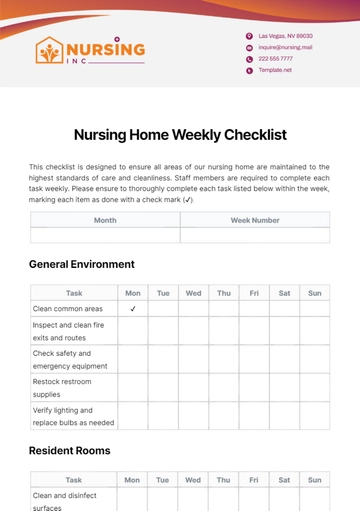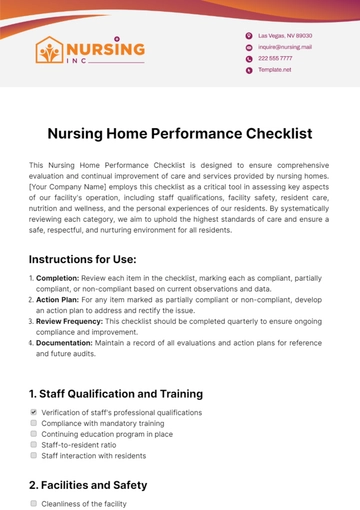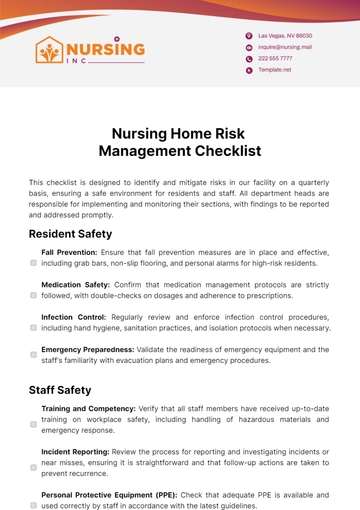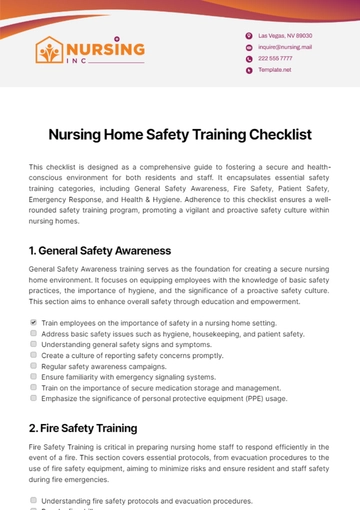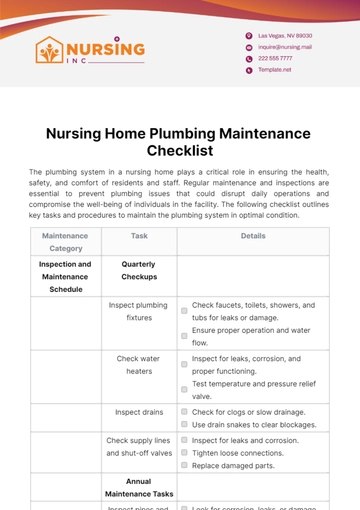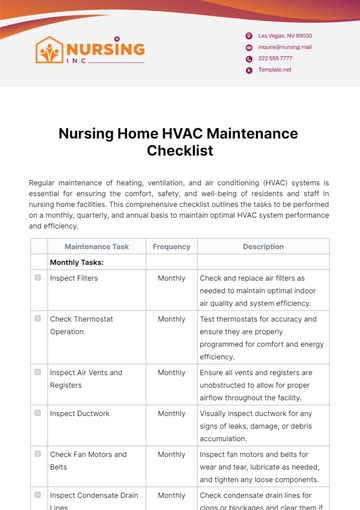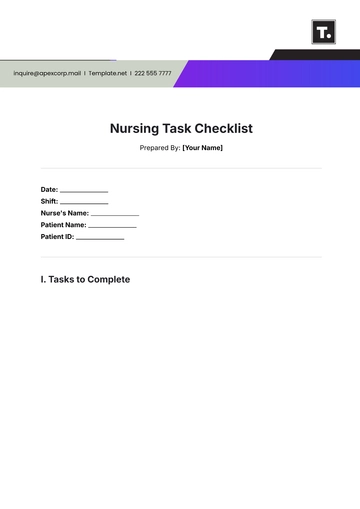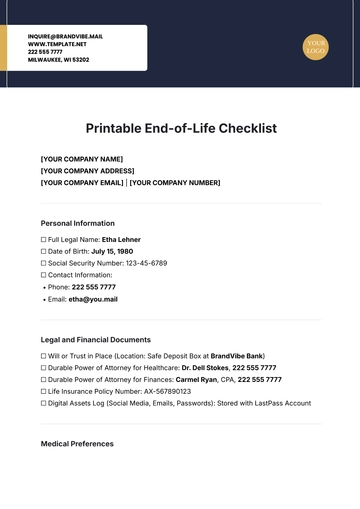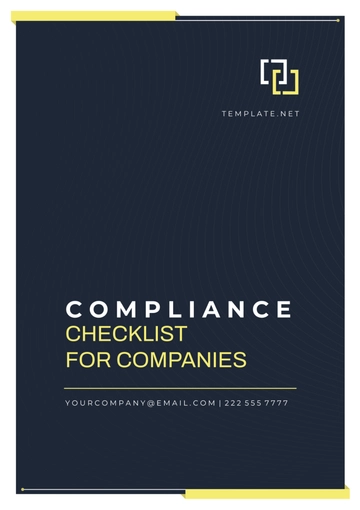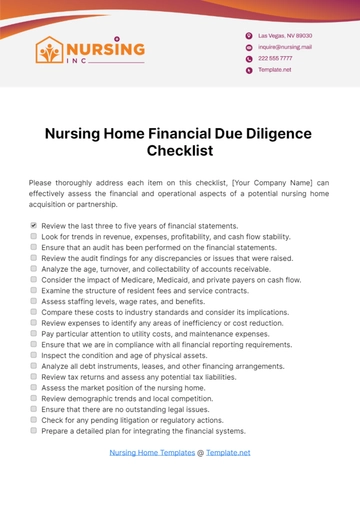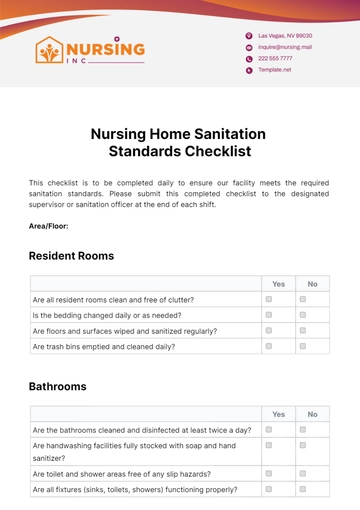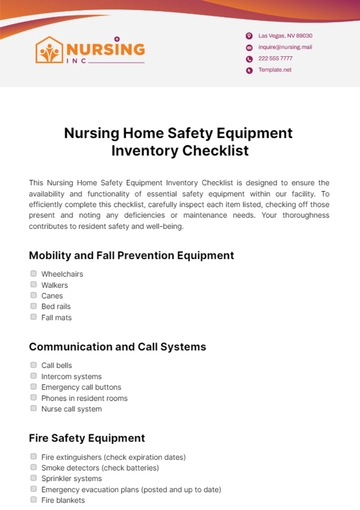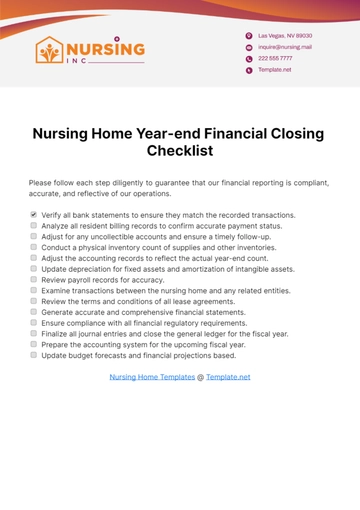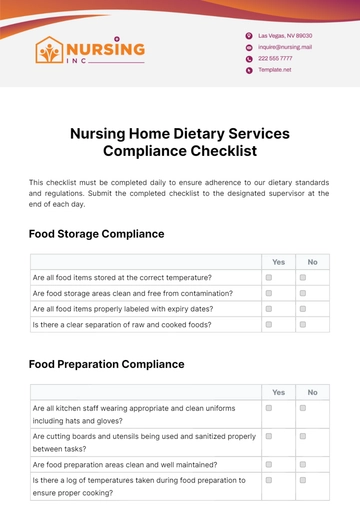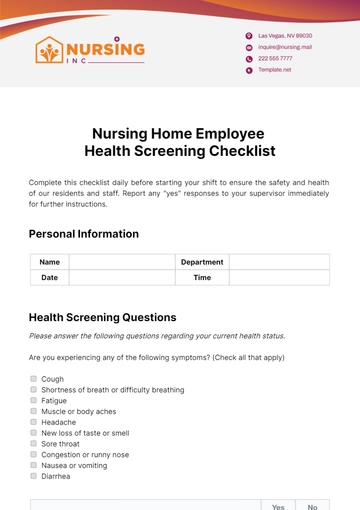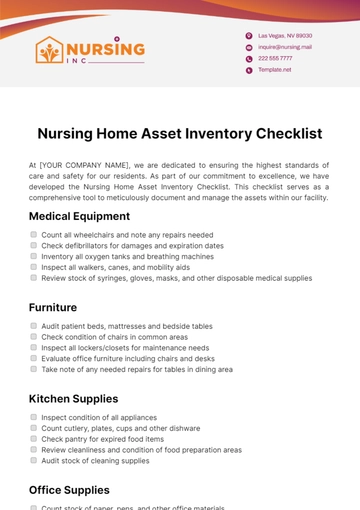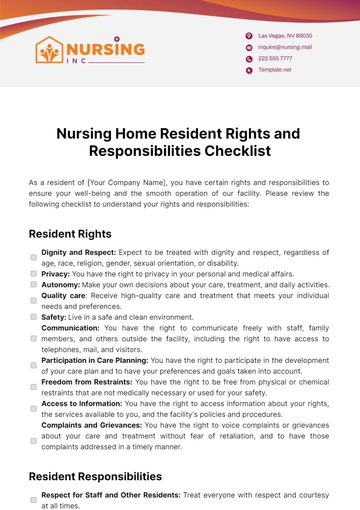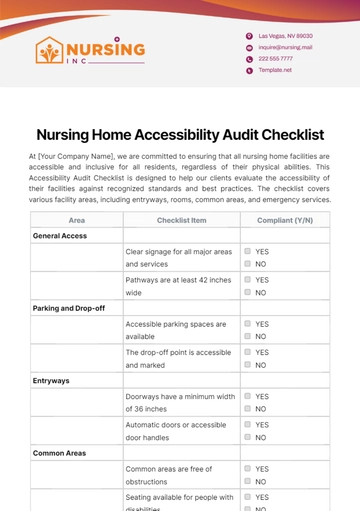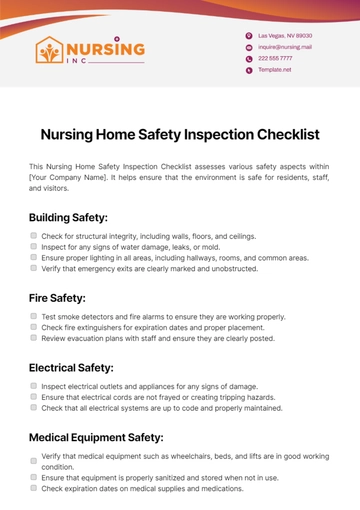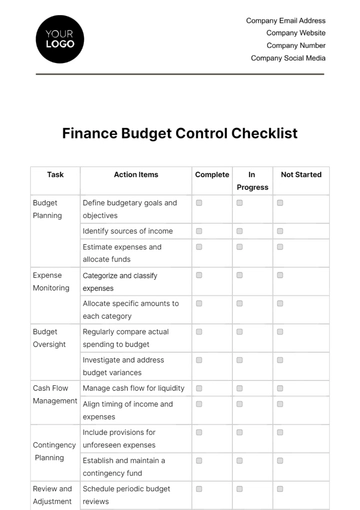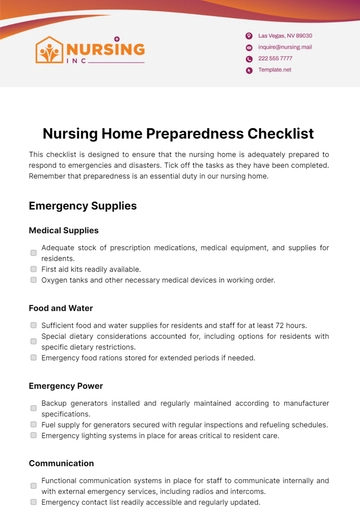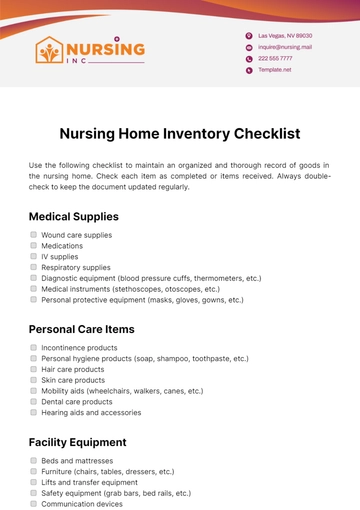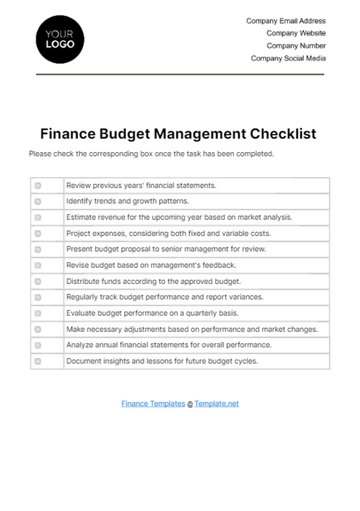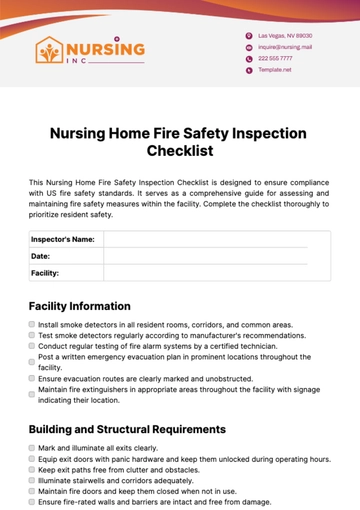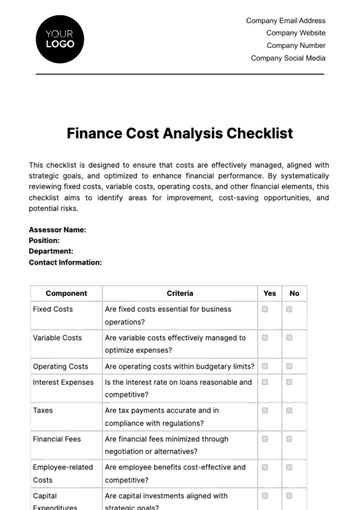Free Nursing Home Risk Management Checklist
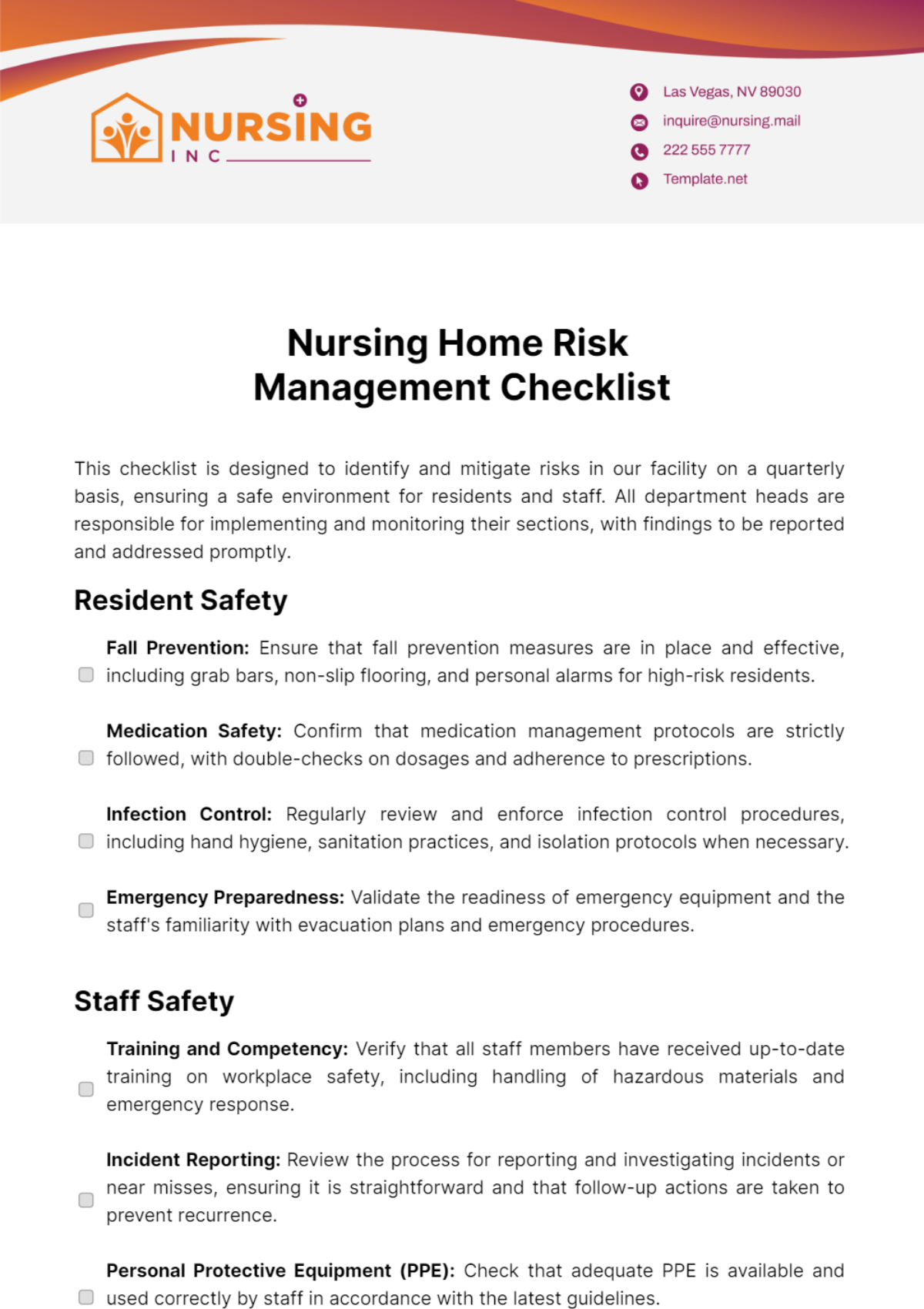
Management Checklist
This checklist is designed to identify and mitigate risks in our facility on a quarterly basis, ensuring a safe environment for residents and staff. All department heads are responsible for implementing and monitoring their sections, with findings to be reported and addressed promptly.
Resident Safety
Fall Prevention: Ensure that fall prevention measures are in place and effective, including grab bars, non-slip flooring, and personal alarms for high-risk residents.
Medication Safety: Confirm that medication management protocols are strictly followed, with double-checks on dosages and adherence to prescriptions.
Infection Control: Regularly review and enforce infection control procedures, including hand hygiene, sanitation practices, and isolation protocols when necessary.
Emergency Preparedness: Validate the readiness of emergency equipment and the staff's familiarity with evacuation plans and emergency procedures.
Staff Safety
Training and Competency: Verify that all staff members have received up-to-date training on workplace safety, including handling of hazardous materials and emergency response.
Incident Reporting: Review the process for reporting and investigating incidents or near misses, ensuring it is straightforward and that follow-up actions are taken to prevent recurrence.
Personal Protective Equipment (PPE): Check that adequate PPE is available and used correctly by staff in accordance with the latest guidelines.
Staff Wellness Programs: Assess the availability and utilization of staff wellness programs to prevent burnout and support mental health.
Facility Maintenance
Building Safety: Conduct regular inspections of the facility to identify and remedy potential hazards, such as structural issues, electrical faults, and unsafe storage practices.
Fire Safety: Ensure that fire safety measures are up to date, including working smoke detectors, fire extinguishers, and clear, unobstructed evacuation routes.
Environmental Hazards: Monitor for environmental hazards, including air quality, water safety, and potential chemical exposures, taking corrective actions as needed.
Security Measures: Evaluate the effectiveness of security measures, including access controls, surveillance systems, and visitor screening processes.
Compliance and Legal Risks
Regulatory Compliance: Regularly review compliance with all applicable health care regulations, including resident care standards, privacy laws, and labor regulations.
Legal Documentation: Ensure that all legal documents, including contracts, consents, and resident records, are complete, up-to-date, and securely stored.
Risk Assessments: Conduct comprehensive risk assessments to identify potential legal and compliance risks, developing action plans to address identified issues.
Insurance Coverage: Review insurance policies to ensure adequate coverage is in place for liability, property, and other potential risks.
Financial Stability
Budget Management: Monitor budget adherence, identifying and addressing any significant variances in revenue or expenses.
Investment in Safety: Assess the allocation of financial resources to safety improvements and risk management initiatives, ensuring it is sufficient and effective.
Billing Practices: Regularly review billing practices for accuracy and compliance with insurance and governmental reimbursement policies.
Financial Risk Assessments: Perform financial risk assessments to anticipate and plan for potential financial challenges, including changes in funding sources and market conditions.
- 100% Customizable, free editor
- Access 1 Million+ Templates, photo’s & graphics
- Download or share as a template
- Click and replace photos, graphics, text, backgrounds
- Resize, crop, AI write & more
- Access advanced editor
Mitigate potential risks effectively with the Nursing Home Risk Management Checklist Template from Template.net. This crucial resource is both editable and customizable, crafted to assist in identifying and managing risks within nursing homes. With our AI Editor tool, personalize your checklist to fit your facility's unique risk management needs, promoting a safer environment for residents and staff.
You may also like
- Cleaning Checklist
- Daily Checklist
- Travel Checklist
- Self Care Checklist
- Risk Assessment Checklist
- Onboarding Checklist
- Quality Checklist
- Compliance Checklist
- Audit Checklist
- Registry Checklist
- HR Checklist
- Restaurant Checklist
- Checklist Layout
- Creative Checklist
- Sales Checklist
- Construction Checklist
- Task Checklist
- Professional Checklist
- Hotel Checklist
- Employee Checklist
- Moving Checklist
- Marketing Checklist
- Accounting Checklist
- Camping Checklist
- Packing Checklist
- Real Estate Checklist
- Cleaning Checklist Service
- New Employee Checklist
- Food Checklist
- Home Inspection Checklist
- Advertising Checklist
- Event Checklist
- SEO Checklist
- Assessment Checklist
- Inspection Checklist
- Baby Registry Checklist
- Induction Checklist
- Employee Training Checklist
- Medical Checklist
- Safety Checklist
- Site Checklist
- Job Checklist
- Service Checklist
- Nanny Checklist
- Building Checklist
- Work Checklist
- Office Checklist
- Training Checklist
- Website Checklist
- IT and Software Checklist
- Performance Checklist
- Project Checklist
- Startup Checklist
- Education Checklist
- Home Checklist
- School Checklist
- Maintenance Checklist
- Planning Checklist
- Manager Checklist
- Wedding Checklist
- Vehicle Checklist
- Travel Agency Checklist
- Vehicle Inspection Checklist
- Interior Design Checklist
- Backpacking Checklist
- Business Checklist
- Legal Checklist
- Nursing Home Checklist
- Weekly Checklist
- Recruitment Checklist
- Salon Checklist
- Baby Checklist
- Equipment Checklist
- Trade Show Checklist
- Party Checklist
- Hospital Bag Checklist
- Evaluation Checklist
- Agency Checklist
- First Apartment Checklist
- Hiring Checklist
- Opening Checklist
- Small Business Checklist
- Rental Checklist
- College Dorm Checklist
- New Puppy Checklist
- University Checklist
- Building Maintenance Checklist
- Work From Home Checklist
- Student Checklist
- Application Checklist

